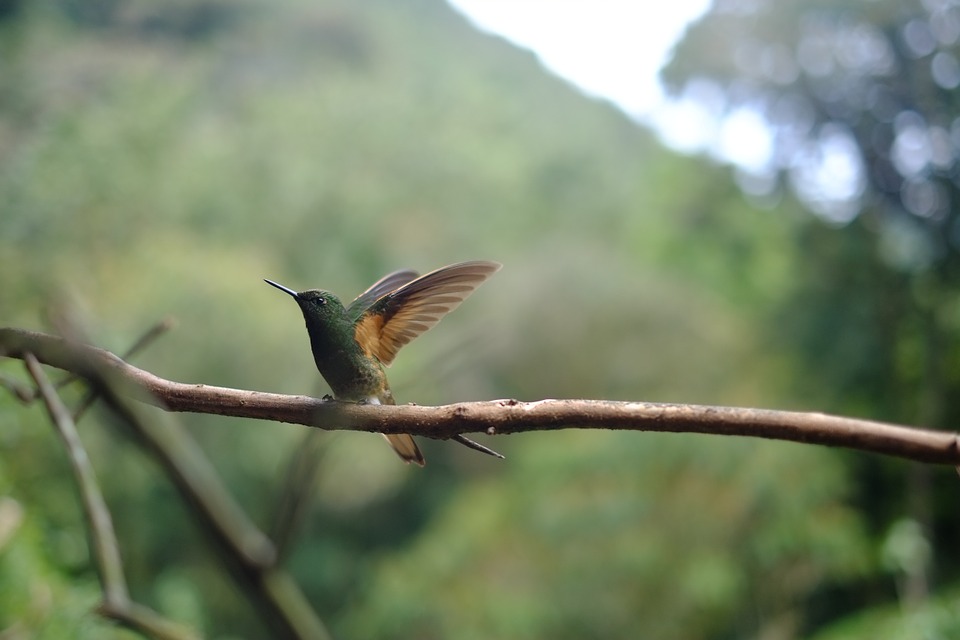
Bring hummingbirds to your garden with native plant life
Article Published by: journalnow.com
For the price of a pound of coffee, you can add to your morning cup of java one of nature’s most sublime creations — ruby-throated hummingbirds.
Yes, it’s that time of year when hummingbirds return to our area after spending the winter in the tropics. And for as little as $12, you can purchase all that is needed to bring this sparkling bird to your garden. Just such an inexpensive feeder hangs outside my window in a place that is easily reached for maintenance and brings the birds so close I can almost touch them.
My hummingbird feeder of choice is a Perky Pet model that has a red flowers with yellow guards that foil bees. Hummingbirds sip sugar water as if these were especially juicy blossoms.
The birds will visit my feeder from April through September and seeing them several times a day will bring me untold joy.
Ruby-throated hummingbirds winter in Mexico and Central America, returning to the eastern U.S. in spring for the breeding season. By putting out feeders in early April, you are likely to have them in place when the first of these birds arrive.
A variety of feeders can be found at Wright’s Birding Center on Country Club Road, Wild Birds Unlimited on Hanes Mall Boulevard and Ace Hardware on Robinhood Road, among others.
The recipe for sugar water couldn’t be simpler. Just mix one part sugar with four parts water and boil it for a few minutes to get the sugar in suspension. Hang the feeder someplace where you can see it easily, and hummingbirds are likely to find their way to you within a couple of weeks.
Excess sugar water can be kept refrigerated for up to two weeks. Good feeder sanitation is important. During cool weather, you may need to clean the feeder and replace the water once a week — twice a week during hot weather, or whenever the water gets cloudy.
This is all you need to do to enjoy hummingbirds throughout the warmer months. But if you’re willing to invest a little more time and energy, you can step up to advanced hummer feeding: gardening for hummingbirds.
Bushes for birds
Hummingbirds metabolize sugar better than humans, so offering them a steady diet of sugar water isn’t the same as loading your children up with sugary drinks. They get plenty of carbohydrates from all that sugar, but they need more than that. They need protein, fat, vitamins and minerals, just as we do.
So where do they get those nutrients? Either directly or indirectly, they get them from plants, especially native plants.
There are many flowering plants that not only provide the nectar that hummingbirds relish, but they attract tiny insects, as well, and it’s those insects that supply the birds with the nutrients missing in nectar alone.
Native plants support many more insects than non-native plants. Some insects are attracted by the nectar, just as hummingbirds are. Others lay their eggs on the plants and the larvae feed on the plants after they hatch. The insects have evolved along with the native plants, adapting to them over thousands of years.
Protein is especially important for rapidly growing nestlings. Hummingbird nestlings go from egg to free-flying bird in just three weeks, and the protein that promotes their growth is provided by the parents in the form of small soft-bodied spiders and insects.
Spiders are important to hummingbirds in another way, too. Fluffy plant parts from thistle and dandelions form much of the material that the females use to build their nests, and they use spider webs to bind those materials together lest they blow away in the wind.
Hummingbirds favor tubular flowers. Their long, slender bills are evolved to reach into flowers of those shapes, and so flowering native plants such as trumpet vine, crossvine, beebalm or the related Oswego tea, cardinal flower and other lobelias are excellent choices.
Several of these flowers can be incorporated into your landscape, or they can be grown as potted plants. Incorporating native plants can be a very rewarding way to beautify your garden while benefitting wildlife.
Coral honeysuckle is a lovely native flowering vine that can be grown either way — in the ground or in a pot — but avoid the common Japanese honeysuckle, as it is a highly invasive non-native plant. Invasive plants grow rapidly and crowd out the more beneficial native plants.
Visit your county’s NC Cooperative Extension Service office and pick up a copy of Butterflies in Your Backyard. Many of the tips for landscaping for butterflies apply equally to hummingbirds. This free booklet lists many more nectar-producing plants, which butterflies use them, and how to landscape your garden for best effect.
Incorporating native plants can be a very rewarding way to beautify your garden while benefitting wildlife. But, if gardening for hummingbirds is more than you care to take on, opt for the sugar water feeder. You will derive many hours of pleasure from watching these feathered jewels.
About Scott Livengood
Scott Livengood is the owner and CEO of Dewey’s Bakery, Inc., a commercial wholesale bakery with a respected national brand of ultra premium cookies and crackers.
Previously, Scott worked at Krispy Kreme Doughnuts for 27 years, starting as a trainee in 1977. He was appointed President of the company in 1992, then CEO and Chairman of the Board.
Scott has served on numerous boards including the Carter Center, the Calloway School of Business and the Babcock School of Management, Habitat for Humanity of Forsyth County, and the Winston-Salem Chamber of Commerce.
He started a new business, StoryWork International, in 2016 with Richard Stone. The signature achievement to date is LivingStories, a story-based program for improved patient experiences and outcomes in partnership with Novant Health.




